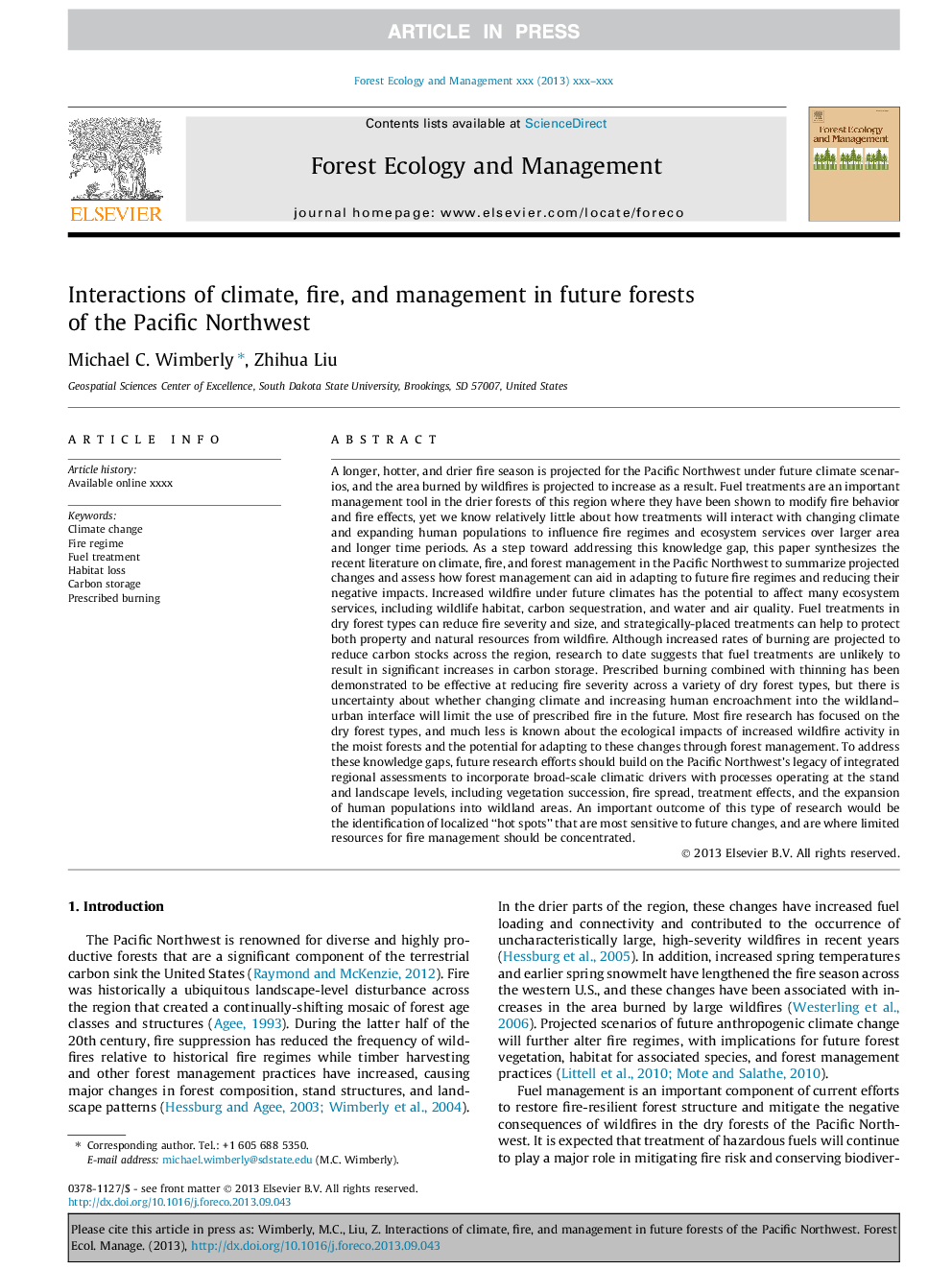| کد مقاله | کد نشریه | سال انتشار | مقاله انگلیسی | نسخه تمام متن |
|---|---|---|---|---|
| 6543437 | 159197 | 2014 | 10 صفحه PDF | دانلود رایگان |
عنوان انگلیسی مقاله ISI
Interactions of climate, fire, and management in future forests of the Pacific Northwest
ترجمه فارسی عنوان
تعاملات آب و هوا، آتش سوزی و مدیریت در جنگل های آینده شمال غربی اقیانوس آرام
دانلود مقاله + سفارش ترجمه
دانلود مقاله ISI انگلیسی
رایگان برای ایرانیان
کلمات کلیدی
تغییر آب و هوا، رژیم آتش، درمان سوخت، نابودی زیستگاه، ذخیره سازی کربن، سوزانده شده،
ترجمه چکیده
یک فصل آتش سوزی طولانیتر، داغتر و خشکتر برای مناطق شمال شرقی اقیانوس آرام در شرایط آب و هوایی آینده پیشبینی میشود و در نتیجه آتش سوزی آتش سوزی آتش سوزی افزایش مییابد. تدارکات سوخت یک ابزار مدیریت مهمی در جنگل های خشک این منطقه است که نشان داده شده است که تغییر رفتار آتش و اثرات آتش را تغییر داده اند، با این حال ما نسبتا کمی می دانیم که چگونه درمان ها با تغییر آب و هوا و گسترش جمعیت انسان برای تأثیر رژیم های فرسوده و اکوسیستم خدمات بیش از منطقه بزرگتر و دوره های طولانی تر. به عنوان یک گام در جهت حل این شکاف دانش، این مقاله، ادبیات اخیر مربوط به آب و هوا، آتش سوزی و مدیریت جنگل ها در شمال غرب اقیانوس آرام را خلاصه می کند تا خلاصه ای از تغییرات پیش بینی شده و ارزیابی نحوه مدیریت جنگل ها در سازگاری با رژیم های آتش سوزی آینده و کاهش اثرات منفی آنها باشد. افزایش آتش سوزی در هوای آفتابی بالقوه می تواند بر روی بسیاری از خدمات اکوسیستم، از جمله زیستگاه حیات وحش، تداخل کربن و کیفیت آب و هوا تاثیر بگذارد. درمان سوخت در انواع جنگل های خشک می تواند شدت و اندازه آتش را کاهش دهد و درمان های استراتژیک می تواند به حفاظت از منابع طبیعی و منابع طبیعی از آتشفشان کمک کند. اگر چه افزایش نرخ سوزی برای کاهش ذخایر کربنی در سراسر منطقه پیش بینی شده است، تحقیقات تا به امروز نشان می دهد که درمان سوخت بعید است به افزایش قابل توجهی در ذخیره سازی کربن منجر شود. سوزاندن اجباری همراه با نازک شدن نشان داده شده است که در کاهش شدت آتش سوزی در انواع انواع جنگل های خشک مقاوم است، اما عدم اطمینان در مورد اینکه آیا تغییر آب و هوا و افزایش نفوذ انسانی به رابط کاربری وحشی و شهری، استفاده از آتش سوزی مجاز در آینده. بیشتر تحقیقات آتش نشانی بر روی انواع جنگل های خشک متمرکز شده است و در مورد اثرات زیست محیطی افزایش فعالیت های آتشفشانی در جنگل های مرطوب و امکان پذیر شدن این تغییرات از طریق مدیریت جنگل ها بسیار کمتر است. برای رسیدگی به این شکاف های دانش، تلاش های تحقیقاتی آینده باید بر مبنای ارزیابی های منطقهای یکپارچه منطقه ای در منطقه شمال غربی اقیانوس آرام باشد تا رانندگان اقلیدات وسیع را با فرآیندهای فعال در سطوح ایستاده و چشم انداز شامل سرچشمه های گیاهی، گسترش آتش، اثرات درمان و گسترش از جمعیت بشر در مناطق حیات وحش. یک نتیجه مهم از این نوع تحقیق می تواند شناسایی مکان های ویژه ای باشد؟ که بیشتر به تغییرات آینده حساس هستند، و جایی که منابع محدود برای مدیریت آتش سوزی باید متمرکز شوند.
موضوعات مرتبط
علوم زیستی و بیوفناوری
علوم کشاورزی و بیولوژیک
بوم شناسی، تکامل، رفتار و سامانه شناسی
چکیده انگلیسی
A longer, hotter, and drier fire season is projected for the Pacific Northwest under future climate scenarios, and the area burned by wildfires is projected to increase as a result. Fuel treatments are an important management tool in the drier forests of this region where they have been shown to modify fire behavior and fire effects, yet we know relatively little about how treatments will interact with changing climate and expanding human populations to influence fire regimes and ecosystem services over larger area and longer time periods. As a step toward addressing this knowledge gap, this paper synthesizes the recent literature on climate, fire, and forest management in the Pacific Northwest to summarize projected changes and assess how forest management can aid in adapting to future fire regimes and reducing their negative impacts. Increased wildfire under future climates has the potential to affect many ecosystem services, including wildlife habitat, carbon sequestration, and water and air quality. Fuel treatments in dry forest types can reduce fire severity and size, and strategically-placed treatments can help to protect both property and natural resources from wildfire. Although increased rates of burning are projected to reduce carbon stocks across the region, research to date suggests that fuel treatments are unlikely to result in significant increases in carbon storage. Prescribed burning combined with thinning has been demonstrated to be effective at reducing fire severity across a variety of dry forest types, but there is uncertainty about whether changing climate and increasing human encroachment into the wildland-urban interface will limit the use of prescribed fire in the future. Most fire research has focused on the dry forest types, and much less is known about the ecological impacts of increased wildfire activity in the moist forests and the potential for adapting to these changes through forest management. To address these knowledge gaps, future research efforts should build on the Pacific Northwest's legacy of integrated regional assessments to incorporate broad-scale climatic drivers with processes operating at the stand and landscape levels, including vegetation succession, fire spread, treatment effects, and the expansion of human populations into wildland areas. An important outcome of this type of research would be the identification of localized “hot spots” that are most sensitive to future changes, and are where limited resources for fire management should be concentrated.
ناشر
Database: Elsevier - ScienceDirect (ساینس دایرکت)
Journal: Forest Ecology and Management - Volume 327, 1 September 2014, Pages 270-279
Journal: Forest Ecology and Management - Volume 327, 1 September 2014, Pages 270-279
نویسندگان
Michael C. Wimberly, Zhihua Liu,
